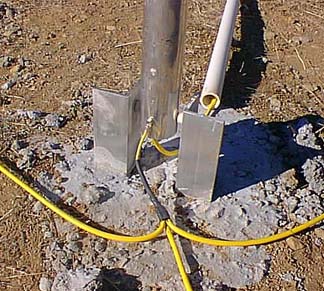|
|
The GAP Voyager DX-IV antenna is 45 feet (13.7 m.) tall and designed to cover 20, 40, 80 and 160 meters. It is guyed at two levels and from four sides. What looks like a single horizontal piece at the top of the antenna is actually one of three capacity hat spreaders that happened to catch the sunlight. The three spreaders are made of 80-inch (2.0 m.) lengths of aluminum tubing. The guy lines are 3/16-inch (4.8 mm) black dacron-polyester double braid cord connected to guy anchors equally spaced at a distance of 25 feet (7.6 m.) from the antenna. Not visible are three 57 foot (17.4 m.) counterpoise wires running out from the base of the antenna. Both the guy lines and counterpoise kit were purchased with the antenna from GAP. The antenna tunes the entire 20, 40 and 80 meter bands with an SWR of 2.0:1 or less. The 2.0:1 bandwidth on 160 meters is 60 KHz, centered on 1860 KHz. This 60 KHz bandwidth is less than the 90 KHz specified by GAP. The antenna is a marginal performer on 20 and 160 meters and a good performer on 40 and 80 meters. |
A
closer view of the top two-thirds of the antenna. Again, one
of the top capacity hat spreaders is catching the sunlight,
but the other two can almost be seen. The
center feed point of the antenna is at the white "gap"
(hence the name) between the top of the two tuning rods
coming up from the bottom and the bottom of the single
tuning rod coming down from the top. The wires connecting
the tuning rods to the feedpoint can also be seen if you
look carefully.

Closeup of three
tuning rods and one of the wire interconnects. The interconnecting
wires came with the lugs pre-crimped, but the crimping was
very poorly done. I removed all lugs and replaced them with
new lugs properly crimped with a good stake crimping
tool. The tuning rods are
designed to fit snugly in the standoffs, but there is
nothing to keep them from falling through except for the
wire connections and occasional rod splices. Even though the
rods do need to move freeley within the standoffs as the
antenna flexes, I secured one standoff per rod with silicon
sealant to minimize stress on the wire
connections.

The antenna is
hinged at the bottom to aid during installation and any
subsequent maintenance. The antenna is
designed to lie flat on the ground when tilted over at the
hinge point. The tuning rods are mounted on three quadrants,
allowing the fourth quadrant to be flat on the ground when
tilted over. Unforunately, the
hinge bolt holes were drilled 90 degrees off, which made
this "feature" a bit more cumbersome than it should have
been. The three-wire
counterpoise connection can be seen, as can the coaxial feed
line entering the antenna for its trip up to the "gap." Both
the counterpoise and antenna are insulated from ground. The
antenna is insulated by the hinge bolt being secured to the
base through nylon bushings.

One of the four guy
anchors. They are elevated because we had two dogs that
loved to run and they might collide with the near-invisible
guy lines if the lines came all the way to the
ground. GAP specifies an
anchor strength of 300 pounds (136 kg). These anchors are
made of 6-foot (1.8 m.) lengths of 1-7/8-inch (4.8 cm)
Schedule 40 water pipe, the bottom 3 feet (0.9 m.) of which
are secured in concrete. (One of the three
yellow counterpoise wires can be seen running across the
ground from left to right in the background.)

|
I purchased this antenna because I wanted a good basic antenna on 80 meters, a backup on 40 and a presence on 160. The GAP Voyager DX-IV has satisfied these requirements very nicely. While GAP multiband antennas typically have a reputation for the two outermost bands being mostly in the imaginations of their Marketing department, I didn't need 20 meters and knew that any antenna like this was going to be marginal on 160 meters. Since I didn't have an amplifier that would cover 160 meters, my barefoot expectations were pretty low to start with, but I was pleasantly surprised. I could join most nocturnal ragchews within a 300-500 mile (500-800 km) radius. For me, this was just fine. The antenna is well designed and made from quality materials. GAP could take a little more care with their production details, but with minimal ad libbing, you wind up with a decent antenna. Under similar circumstances, I would buy another. |
Go back to Antennas
Page.
Go back to Home
Page.
Copyright © 1999, 2002 Dick Flanagan K7VC. All rights reserved. Updated December 9, 2002